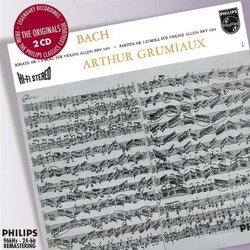| All Artists: Johann Sebastian Bach, Egida Giordani Sartori Title: Bach: Sonatas & Partitias Members Wishing: 1 Total Copies: 0 Label: Philips Release Date: 7/4/2006 Album Type: Original recording remastered Genre: Classical Styles: Chamber Music, Historical Periods, Baroque (c.1600-1750), Classical (c.1770-1830), Instruments, Strings Number of Discs: 1 SwapaCD Credits: 1 UPC: 028947575528 |
Search - Johann Sebastian Bach, Egida Giordani Sartori :: Bach: Sonatas & Partitias
 | Johann Sebastian Bach, Egida Giordani Sartori Bach: Sonatas & Partitias Genre: Classical
|
Larger Image |
CD Details |
CD ReviewsIf I could have only one Bahij Bawarshi | Beirut, Lebanon | 10/08/2008 (5 out of 5 stars) "If you have ever fancied playing "desert island discs", you know the difficulty of deciding which ten, let alone five, discs to choose. Were the choice limited to one, the task would be practically impossible. I have tried it and stopped trying in a short while. Nevertheless, this recording of Arthur Grumiaux playing Bach's Sonatas and Partitas for Solo Violin keeps coming to my mind as a strong contender for top place. It appears to be the same as the Philips 50 edition, now out of print. It differs from another Philips recording still available from Amazon.com by having, in addition to the solo violin sonatas and partitas, two sonatas for violin and harpsichord, better sound quality, and excellent liner notes by Julian Haylock, British author of books on music and former editor of CD Review magazine. Sometimes, when I listen to the two CDs of this package in one session (as I listen to each piece, I want more), I save Partita No. 2 in D minor until the last because of its concluding Chaconne -- 13 minutes of music to end all violin music! In the words of Julian Haylock, it is "a virtual summation of the solo violin's expressive capabilities." I am almost tempted to say that by itself it is worth the price of this set, but that would be unfair to the rest of what we have here. The whole volume is a sparkling example of great music. Bach's compositions are "cerebral" (as in the fugues of the three sonatas), touching (as in the opening adagio of Sonata No. 3), spirited, lyrical and altogether beautiful. Grumiaux's violin, with its full, golden sound, is captivating. I can say that when I listen to the music, delight is total, satisfaction is complete, every time. Another distinctive aspect of the music is that it benefits from what Haylock calls, "Bach's transcendental compositional command and well-developed insight into the violin's potentialities [as a polyphonic instrument]." During certain moments I could swear that more than one violin was being played simultaneously (a tribute, incidentally, not only to Bach's genius but also to Grumiaux's skill). Haylock pins it down like this: "[Bach's] natural inclinations, and indeed the very foundations of his musical style, were built upon the keyboard. Although in the purist sense Bach composed untold masterpieces for essentially legato instruments such as the violin, cello and human voice, the design and shape of his melodic lines were dictated by polyphonic instinct based on a textual clarity essentially alien to a sustaining instrument. The sonatas and partitas are supreme masterpieces ingeniously laid out for the violin, rather than classic examples of idiomatic violin writing per se." That also means that some parts of the sonatas and partitas are not easy to follow, especially by those not familiar with Bach's style. Yet repeated listening will increase true appreciation of the music; even those who are well acquainted with Bach will discover more in these compositions each time they hear them anew. On the other hand, the two sonatas for violin and harpsichord filling out CD 2 are easy to follow and very enjoyable. The harpsichord sometimes accompanies the violin continuo-style, at other times it is more of a partner in the flow of the music, but at all times Grumiaux's brilliant violin sound is dominant." High tensile-strength Bach... Sébastien Melmoth | Hôtel d'Alsace, PARIS | 07/13/2010 (5 out of 5 stars) ".
High tensile-strength Bach... . Approaching without preconceptions, Grumiaux' 1960-61 traversal of Bach's solo Sonatas and Partitas conveys a potential jolt of electrifying `shock of the new', for his steely Modernistic esthetic is immediately palpable in this teleos-based vision. Grumiaux takes an acute attitude without any appearance of haste: he simply gets on with it. His technical ability is astounding: he executes the grace-notes, trills, and baroque flourishes with incredible precision. Bach calls for chords which must be arpeggiated on the violin and Grumiaux digs in on the treble and catches the soprano notes with high definition. The 2006 96kHz 24-bit immaculately remastered sound is extraordinarily clear. Bonus tracks include two duo Sonatas with harpsichord. . Szeryng Bach: Sonatas & Partitas for Solo Violin Milstein Bach: Sonatas and Partitas for Solo Violin Mintz Sonatas & Partitas ." |

 Track Listings (21) - Disc #1
Track Listings (21) - Disc #1